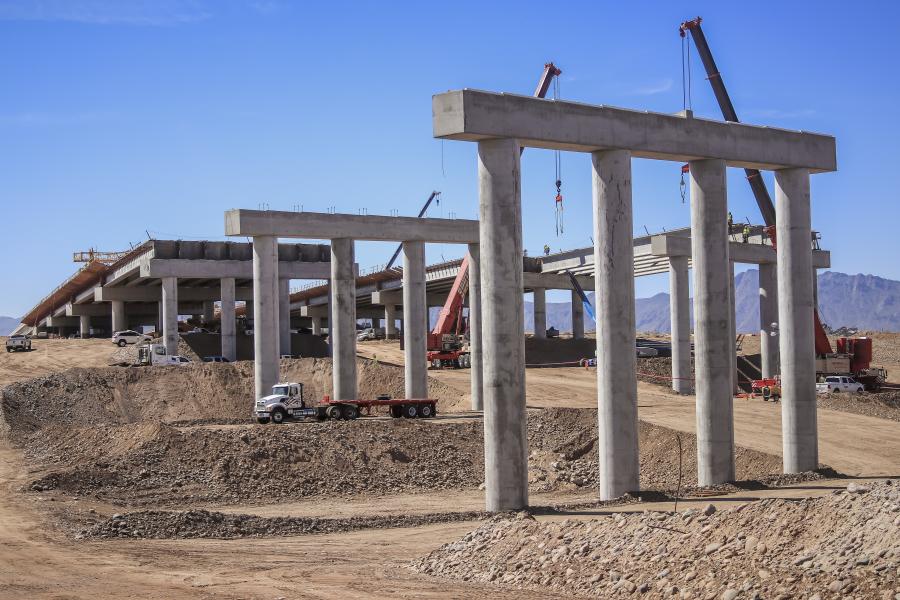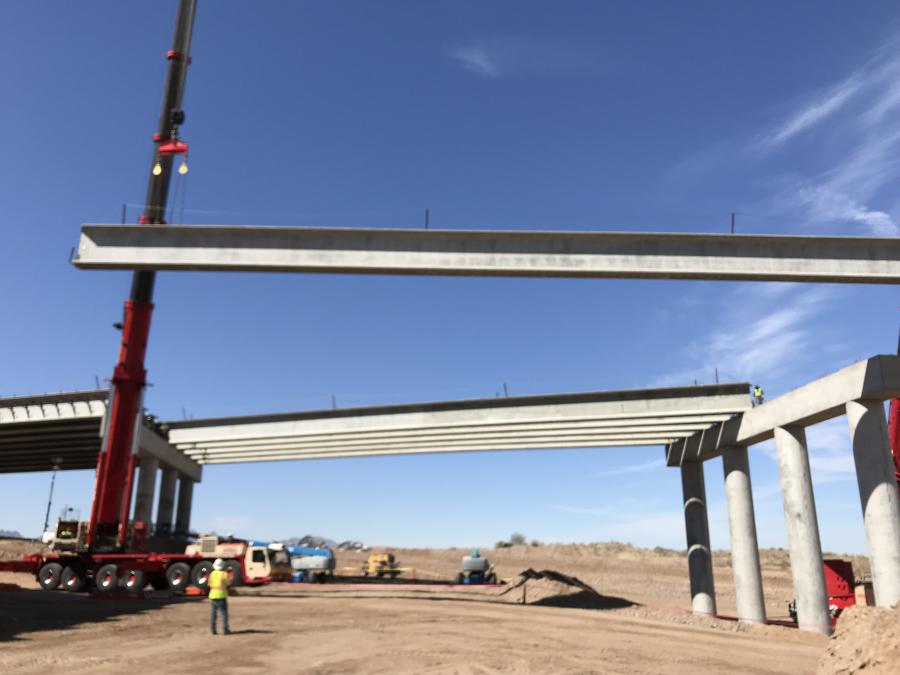Approximately $1.7 billion was provided for the Maricopa Association of Governments Regional Transportation Plan in fiscal years 2016-2020 for the South Mountain Freeway.
(Arizona Department of Transportation photo)
The Loop 202, Arizona's South Mountain Freeway, will add 22 mi. of freeway to the existing Phoenix metropolitan transportation system, easing traffic congestion and connecting the east and west valleys.
Major construction began in early 2017. The project is scheduled for full completion in 2020, although traffic is expected to be using the freeway earlier. Most construction occurs on weekdays, although some construction activities will require work every day and overnight.
Approximately $1.7 billion was provided for the Maricopa Association of Governments Regional Transportation Plan in fiscal years 2016-2020 for the South Mountain Freeway. The amount includes design, right-of-way, construction, utility and administrative costs. It is the largest single highway project in Arizona history.
Freeway Links Two Valleys
The South Mountain Freeway will provide a long-planned direct link between the East Valley and West Valley and a much-needed alternative to I-10 through downtown Phoenix. Approved by Maricopa County voters in 1985 and again in 2004 as part of a comprehensive Regional Transportation Plan, the South Mountain Freeway will complete the Loop 202 and Loop 101 freeway system in the Valley.
The project is the last piece to complete the Loop 202 system in the Phoenix metropolitan area. The South Mountain Freeway will run east and west along Pecos Road and then north and south between 59th and 63rd avenues, connecting with Interstate 10 on each end.
Construction includes 40 bridges and 15 traffic interchanges with on-and-off ramps, including the 32nd Street and Ivanhoe Street interchanges that were added to the project and will be completed in 2020.
A Design-Build Project
Connect 202 Partners is responsible for the design and construction of the freeway and will provide maintenance after construction. The joint venture is led by Fluor Enterprises Inc., Granite Construction Co. and Ames Construction Inc., with Parsons Brinckerhoff Inc. (now WSP) as the lead designer. Maintenance services contractor DBi Services LLC will be jointly responsible for ongoing highway maintenance and any necessary capital improvements for 30 years after substantial completion.
C202P is self-performing earthwork, drainage, bridge construction, traffic control and asphalt paving and managing the other aspects of the project including noise walls, overhead signage and intelligent transportation system infrastructure for the project.
The team is contracting for design and engineering support, security, hauling services, environmental cleanup, demolition, clearing operations, landscaping and other scopes of work. It is anticipated C202P will contract with more than 120 companies.
Approximately 1 million tons of asphalt and 150,000 cu. yds. of concrete will be applied over the course of the project.
Heavy equipment at the project site includes cranes, drilling equipment, bulldozers, loaders, excavators, scrapers and paving equipment.
Complex Project Moving Along
Progress is evident throughout the 22-mi. corridor as crews put down asphalt pavement, complete bridges, build artistic sound walls and install message boards above the future travel lanes.
"Construction and design are more than two-thirds complete," said Dustin Krugal, ADOT public information officer.
Crews have now installed 20 mi. of drainage pipe; laid 107,000 tons of asphalt pavement; moved 9.9 million cu. yds. of dirt; and used 10,800 tons of steel rebar for bridges, walls and other structures.
In 2019, construction will ramp up, Krugal said.
Some of the 2019 construction highlights include:
- Paving the entire 8-lane freeway.
- Completing 40 bridges throughout the corridor, including two half-mile-long spans over the Salt River.
- Constructing two flyover HOV ramps in the I-10 median for the I-10 and Loop 202 interchange.
- Shifting Pecos Road traffic onto portions of the freeway mainline through Ahwatuk.
- Moving 59th Avenue traffic onto newly-constructed Loop 202 frontage roads between the I-10 Papago Freeway and Lower Buckeye Road.
- Completing construction of Arizona's first two diverging diamond interchanges at Desert Foothills Parkway and 17th Avenue.
- Building five multi-use underpasses in the Center segment (51st Avenue to 32nd Lane) providing people and wildlife access to and from South Mountain Park.
With so much Loop 202 construction to come in 2019, motorists should be prepared for periodic roadway closures and extended traffic shifts around the work zones. A 6-mi. section of Pecos Road will be permanently closed and be repurposed into a 6-mi.-long shared-used path between 17th Avenue and Desert Foothills Parkway.
An Innovative Plan
For the largest project in state history, ADOT partnered with private developer Connect 202 Partners to design, build, and maintain the freeway for 30 years. The design-build-maintain delivery model is an innovative approach used nation-wide to efficiently reduce the cost to taxpayers without sacrificing quality.
Connect 202 Partners continues to make progress along the future 22-mi. corridor. Upon completion, the developer will be responsible for maintaining the freeway and ensuring the safety of the traveling public for 30 years.
Benefits
The freeway, which was twice approved by voters in Maricopa County, will provide a direct link for commuters traveling between the East Valley and West Valley, and much-needed alternative to taking Interstate 10 through downtown Phoenix. The South Mountain Freeway also is the last piece to complete the Loop 202 and Loop 101 freeway system necessary for high-quality regional mobility.
In addition, the South Mountain Freeway is designed to save both time and money for a fast-growing region. When it opens by the end of 2019, the long-planned link between the East Valley and West Valley is projected to deliver an immediate savings of 15 million hours of travel time, worth $200 million, over the course of the year.
When it opens to traffic, the long-planned link in the Phoenix metropolitan area is expected to improve living and business conditions, including economic growth.
Pedestrian Bridge
The pedestrian bridge will be designed and constructed by Connect 202. Public art also will be incorporated into the pedestrian bridge in coordination with the city of Phoenix Office of Arts and Culture.
Dust Control
Dust control is a priority for the construction team. Keeping the soil moist during ground-disturbing activities is the most effective means for preventing dust.
Water spraying and soil stabilization materials will be used in all construction areas. Water will be sprayed on the dirt before, during and after the construction activity.
Track out devices will be used at the construction site entrances and exits to reduce the amount of dirt vehicles track out onto adjacent streets. When possible, the number of vehicles in the construction area will be minimized.
The city of Phoenix Street Transportation Department will conduct a traffic study to evaluate the potential impacts of construction on local traffic and residential neighborhoods between Pecos Road and Chandler Boulevard from 17th Avenue to I-10. Additional focus will be placed on the intersections at 40th Street and Cottonwood Lane; 17th Avenue and Chandler Boulevard; and Liberty Lane at 24th Street and 32nd Street to understand the possible anticipated traffic patterns due to the change of Pecos Road to a State highway.
Noise
Two primary sources of noise are being addressed: equipment engine noise and back-up alarms. The construction team understands these alarms are disruptive to the adjacent residents.
Because back-up alarms have proven to reduce the number of construction fatalities, the Occupational Safety and Health Administration requires the alarms to be used and that they be audible above the surrounding construction noise.
CEG
Today's top stories






















